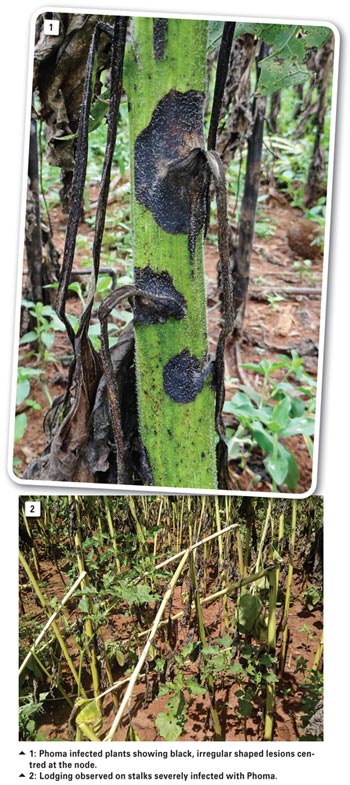April 2015
MOSES RAMUSI and BRADLEY FLETT, ARC-Grain Crops Institute
Phoma black stem is caused by the soil-borne fungal pathogen Phoma macdonaldii, which occurs in some of the major sunflower production areas of South Africa. Severe infections on susceptible hybrids can cause up to 100% yield losses in one particular field.
Disease survey results from the 2012/2013 and 2013/2014 seasons conducted by the ARC-Grain Crops Institute revealed that Phoma-like infected sunflower symptoms were observed in some parts of Limpopo (Naboomspruit) and the North West Province (Carletonville).
 Epidemiology of the disease
Epidemiology of the disease
The pathogen survives as pycnidia/perithecia on plant debris in the soil and can also be seed-borne. The fungus is disseminated through water (rainfall/irrigation) and by insects such as Apion occidentale and Cylindrocopturus adspersus stem weevils, which feed on sunflower. Infection can occur anytime during the growing season when conditions are favourable (wet, humid and high temperatures).
During the infection process, perithecia release ascospores, which infect the leaves. Adult sunflower stem weevils feeding on the leaves cause lesions whereas contaminated larvae spread the fungus as they tunnel throughout the stem. Infected leaves die while the pathogen spreads to the petiole and stem, forming irregular shaped symptoms at the node. Infection can also occur through mycelia at the basal part of the plant.
Symptoms of the disease
The disease is characterised by light to dark brown/black irregular shaped lesions centred at the node (Photo 1).
The lesions originate from the leaf infections that progress down the petiole to the stalk. Under favourable conditions, the leaf wilts, petiole turns uniformly black and the stem lesions expand to form a large, shiny, black patch with well-defined borders.
Small, circular fruiting bodies of the fungus are visible on the surface of the stem. Pith damage may occur right on the petiole and as a result, mid-stem lodging can occur (Photo 2).
Disease control
The fungus overwinters in infected sunflower debris on the soil surface. Deep ploughing that burry plant residue as well as crop rotation can accordingly reduce incidences and severity of the disease. Crop rotation is important as it prevents disease build-up in the field by interfering with the life-cycle of the disease on its host, the sunflower.
Leaving crop residue on the soil surface will also encourage the development of the disease. Control of insects such as sunflower stem weevils can help minimise the spread of the disease. Dense plant stands favour black stem development, therefore, optimum plant densities and nutritional inputs can reduce infection. No hybrids have been identified as being immune to the disease, although some hybrids appear to be more tolerant than others.
For more information, contact Moses Ramusi at ramusim@arc.agric.za.

Publication: April 2015
Section: On farm level